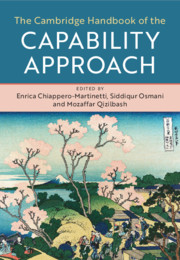Book contents
- The Cambridge Handbook of the Capability Approach
- The Cambridge Handbook of the Capability Approach
- Copyright page
- Dedication
- Contents
- Figures
- Tables
- Contributors
- Foreword
- Acknowledgements
- General Introduction
- Part I Historical Antecedents and Philosophical Debates
- Part II Methods, Measurement and Empirical Evidence
- Introduction to Part II
- 13 Social Choice and the Capability Approach
- 14 On Capability and its Measurement
- 15 Analyzing Capabilities
- 16 Implementing the Capability Approach with Respect for Individual Valuations
- 17 Capability, Opportunity, Outcome and Equality
- 18 The Distribution of Capabilities
- 19 Inter-Group Disparities in the Distribution of Human Development
- 20 Multidimensional Inequality and Human Development
- 21 The Research Agenda on Multidimensional Poverty Measurement
- 22 Measuring Gender Inequality Using the Capability Approach
- 23 Econometric and Statistical Models for Operationalizing the Capability Approach
- 24 Expanding Capabilities through Participatory Action Research
- Part III Issues in Public Policy
- Index
- References
21 - The Research Agenda on Multidimensional Poverty Measurement
Important and as yet Unanswered Questions
from Part II - Methods, Measurement and Empirical Evidence
Published online by Cambridge University Press: 11 November 2020
- The Cambridge Handbook of the Capability Approach
- The Cambridge Handbook of the Capability Approach
- Copyright page
- Dedication
- Contents
- Figures
- Tables
- Contributors
- Foreword
- Acknowledgements
- General Introduction
- Part I Historical Antecedents and Philosophical Debates
- Part II Methods, Measurement and Empirical Evidence
- Introduction to Part II
- 13 Social Choice and the Capability Approach
- 14 On Capability and its Measurement
- 15 Analyzing Capabilities
- 16 Implementing the Capability Approach with Respect for Individual Valuations
- 17 Capability, Opportunity, Outcome and Equality
- 18 The Distribution of Capabilities
- 19 Inter-Group Disparities in the Distribution of Human Development
- 20 Multidimensional Inequality and Human Development
- 21 The Research Agenda on Multidimensional Poverty Measurement
- 22 Measuring Gender Inequality Using the Capability Approach
- 23 Econometric and Statistical Models for Operationalizing the Capability Approach
- 24 Expanding Capabilities through Participatory Action Research
- Part III Issues in Public Policy
- Index
- References
Summary
The application of multidimensional poverty measures is proliferating, in part due to the emphasis in Goal 1 of the Sustainable Development Goals (SDGs) on ending poverty in all its forms and dimensions. This chapter first traces the emergence of a priority for non-monetary poverty measures in key texts that considered and then set out the SDGs. It then outlines some vital and feasible research questions on a subset of fascinating empirical topics on counting-based multidimensional measures. The topics covered here relate to the SDGs’ focus on measuring the multidimensional poverty of men, women and children. Building on the existing literature, fascinating questions remain in terms of measurement design (the selection of dimensions, indicators, cut-offs and weights), the analysis of multidimensional poverty measures, their application to child poverty and their implementation using gendered data. In each of these areas, it is expected that significant breakthroughs are possible.
- Type
- Chapter
- Information
- The Cambridge Handbook of the Capability Approach , pp. 417 - 436Publisher: Cambridge University PressPrint publication year: 2020



